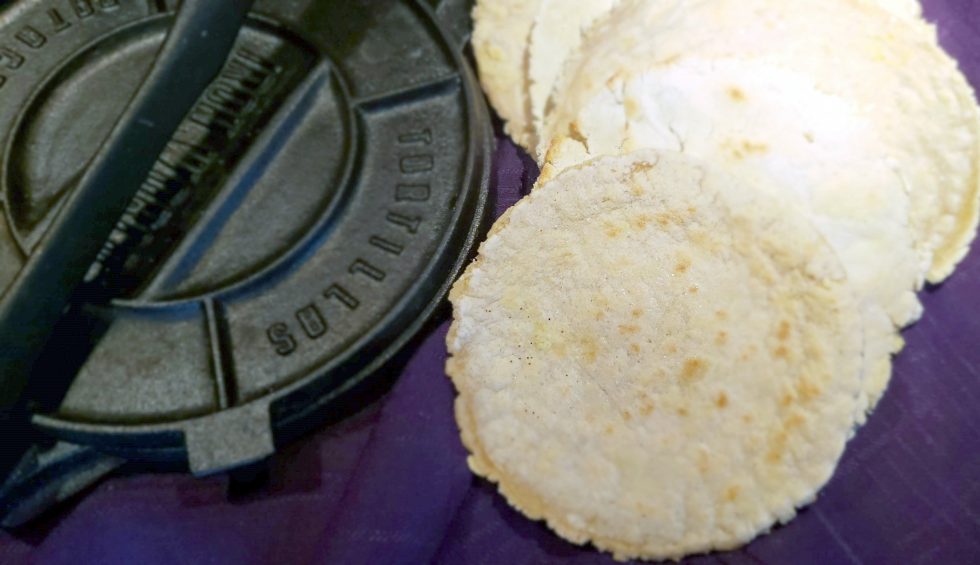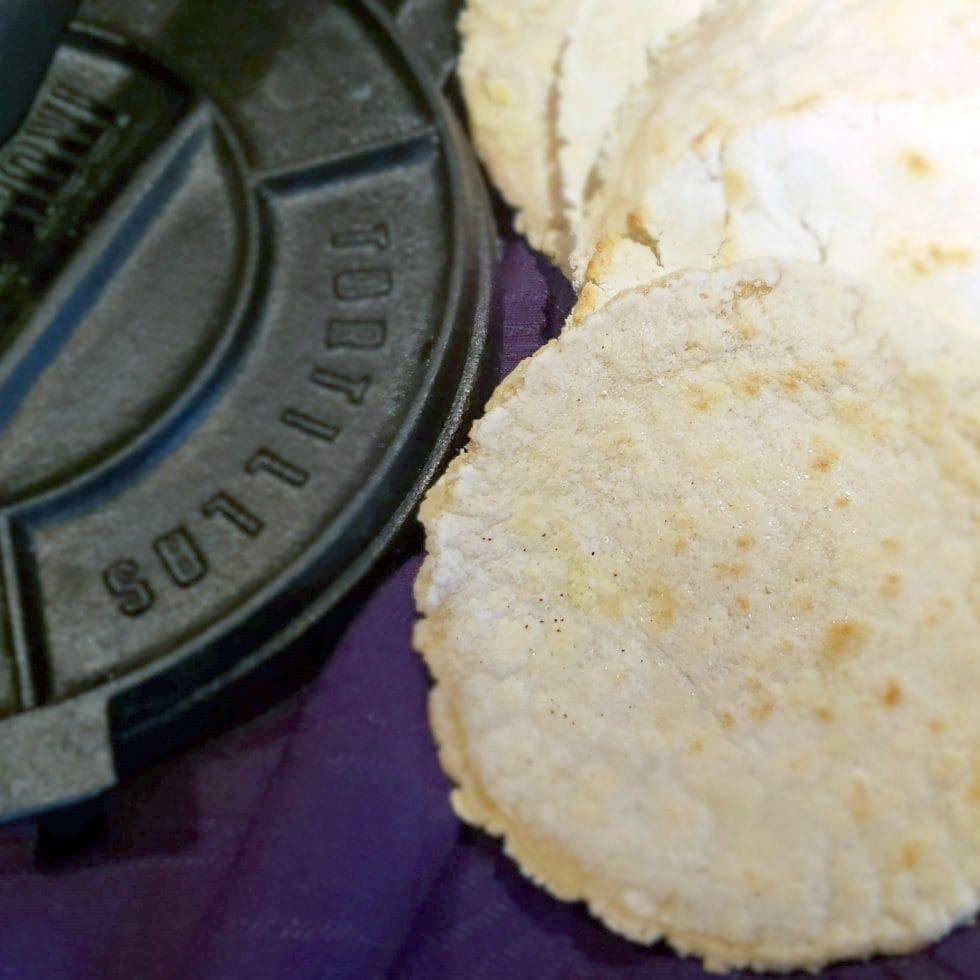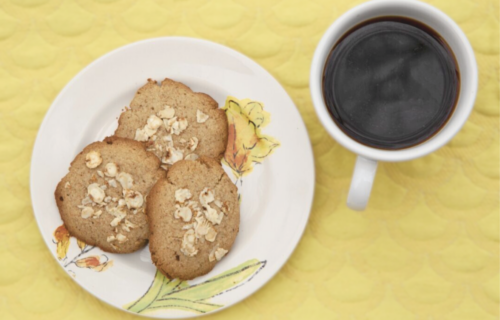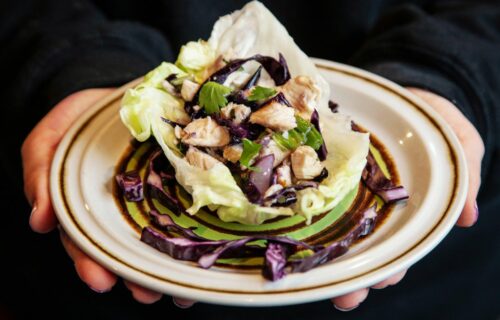
Low Histamine Cassava Tortillas (also Low Lectin & Medium Oxalate)
I love flatbreads and tortillas. In the past, I bought the pre-made ones I found in the store. I used them in everything from quesadillas to wraps to pizzas. They were so easy to use as a base for quick and easy meals.
But I had to make some changes when I realized I was dealing with Histamine Intolerance and Lectin Intolerance.
I found out I was reacting to corn tortillas. (Corn is high in lectins.)
I reacted to flour tortillas, too.
Flatbreads weren’t any better, even if they were gluten free.
I’ll tell you more about why I was reacting to these things (and why you may be too!) in just a minute.
Anyway, I couldn’t have corn or flour tortillas anymore. And flatbread was out, too.
I’d heard of cassava tortillas as an alternative, though. So, I looked into some of the easy to use pre-made cassava tortillas I’d seen at Whole Foods.
But I reacted to those, too…even the Siete Cassava Flour Tortillas available in the freezer section.
It may be due to the time they sat in the freezer. Products like these can sit for months. It could also be the added xanthan gum, which is high histamine.
Or it might be the cassava flour they use. I’ve since found out that not all cassava flours are made equally!
I wasn’t ready to give up on finding a good replacement for tortillas, though.
I’d see my husband eat tacos with flour tortillas, and I really wanted to have taco night with him again.
That got me thinking I should look into making my own tortillas.
Low Histamine Cassava Tortillas
I love this homemade Cassava Flour Tortilla recipe! I mentioned that not all cassava flour is the same. I found one that worked well for me. (More on that in a bit.)
These cassava tortillas are:
- Low histamine
- Medium oxalate
- Low lectin
- Gluten free
- Grain free
They freeze really well, too. This makes them perfect to pull out for a quick meal or snack.
These Cassava Flour Tortillas work great for wraps, open-faced sandwiches, or as a bread substitute. These hold up really well and taste great!
Next, remember how I told you that corn and flour tortillas and even gluten-free flatbreads were adding to my mast cell flares?
Here’s why that was happening for me and why it may be happening for you, too.
Why Use Cassava Flour for Tortillas?
If you are using store-bought flatbreads or tortillas like I was, here’s how they may be contributing to your reactions.
Most flours are made from grains. Many grains are high lectin. Lectins can be mast cell triggers for some people. If you have Mast Cell Activation syndrome, this can mean more inflammation.
That’s one reason why I was reacting to wheat flour, and the gluten-free products that used grains like corn, quinoa, and buckwheat.
Bleached, wheat flour is high histamine.
And there are often a lot of preservatives in store-bought products. Many preservatives can be high histamine, too.
With Mast Cell Activation Syndrome or Histamine Intolerance, you want to reduce mast cell triggers and reduce your histamine load. Finding alternatives like grain-free foods may help.
That’s why I was excited to work with cassava flour.
Cassava flour is different because it comes from the yuca root. Tapioca flour comes from the same plant, but a different part. Cassava root is peeled, dried, then ground into flour.
That means it’s grain-free! And great news: it substitutes well for wheat flour in many recipes because it’s starchy.
Cassava flour has a lot of other benefits, too. Let’s look at those next.
Benefits of Cassava Flour
Cassava flour is low histamine. So, unlike bleached, wheat flours, this won’t add to your histamine load.
Here are some other benefits of using cassava flour:
- Low carb
- Dairy free
- Gluten free – many with mast cell activation issues struggle with corn tortillas
- Grain free
- Nut free – unlike coconut flour and almond flour tortillas
- Soy free – soy can be a mast cell trigger
- AIP friendly
- Calcium
- Potassium
- Vitamin C
- Resistant starch – feeds good bacteria
But here’s the first thing to know about cassava flour. They are not all made the same.
I’ve tried different cassava flours. I had reactions to pre-made products using cassava flour. And I had trouble with some cassava flours even when I made food from scratch.
As I found out, many cassava flours are fermented. Fermented foods are high histamine.
Not great if you have Histamine Intolerance.
But I really was determined to eat tacos again!
So, I kept looking. I finally found a cassava flour that would give me all of the benefits listed above AND it wasn’t made using fermentation.
That brand is Otto’s Cassava Flour.
The Best Brand of Low Histamine Cassava Flour
Otto’s Cassava Flour is the only brand of cassava flour I know that isn’t fermented. That means it’s a lower histamine cassava.
Otto’s Cassava Flour has never bothered me. Many of my clients have done well with it, too.
And in terms of quality checks, Otto’s tests each batch for quality. When a company has that kind of practice, it really puts my mind at ease.
Cassava is also a lectin-free food!
>>>>Use my code mastcell360 to get 10% off your Otto’s cassava flour.
Now, there are a couple cautions you should know about cassava flour before you dive in. Let’s look at that next.
Cautions for Cassava Flour
Otto’s is lower in oxalates than other cassava flours on the market. That’s the good news.
But cassava is still considered medium to high oxalate, though. However, if you do have oxalate issues, cassava flour is still a much better choice than almond flour.
When Otto’s was tested, it registered as 17mg soluble oxalates per 1/4 cup. And yes, that is considered a high oxalate level. It’s still lower than some other brands, though.
But with oxalates, the amount you eat also matters. It’s high oxalate at ¼ cup of cassava flour. If a recipe comes out to ¼ cup of flour per serving, that recipe would be considered high oxalate.
If you ate this whole recipe in one sitting, that would be considered a high oxalate level.
A recipe with ⅛ cup or less per serving would be considered medium.
This recipe makes 13 (a baker’s dozen) 5-inch tortillas. And that comes out to somewhere between ⅛ and ¼ cup.
You may have oxalate sensitivity, but you may be able to handle some oxalates, sometimes.
If you aren’t sure, you might consider trying one cassava flour tortilla to start. You can also make it really thin to lessen the amount you are eating in one sitting.
Just like with histamine issues…you might be able to eat one strawberry, but a strawberry pineapple smoothie made with soy milk might result in a flareup.
And just like with histamine issues, if your oxalate issues are severe, even just a little may be too much.
Just remember…everyone is unique.
If you aren’t tolerating many foods in general, or if you have severe oxalate issues, even a quality product like Otto’s Cassava might be too much for you to handle.
And you should know that cassava is in the rubber plant family. Bananas and latex come from the same family.
If you have allergies to latex or issues with bananas (besides histamines), then you may not want to use cassava. Or at least test a tiny amount first to make sure you don’t react.
If you are very sensitive to oxalates, you may want to try these coconut wraps instead.
But this flour may be your new best friend in the kitchen if you don’t have sensitivities to cassava!
Feeling good about cassava? Great! I’ve got some good tips for preparing the tortilla dough for you next.
How to Make Cassava Tortillas
I found the secret to making these tortillas quickly is to use a Tortilla Press like one of these.
I also use unbleached parchment rounds to keep the dough from sticking. However, if you don’t have these, you can use a rolling pin or even your hands.
TIP: If you don’t have a tortilla press, still use unbleached pieces of parchment paper under the rolling pin so they don’t stick! It will also make the rolling pin easier to clean.
Sometimes if I’m just making one or two tortillas, I’ll just pat the dough out right into the skillet. (Before the skillet is turned on, of course.) That method isn’t pretty, but it is fast!
But I usually make a big batch of these with the tortilla press. The tortillas come out more consistently. They look nicer, too. And the tortilla press is fast!
Now that you’ve got your tortillas rolled out, you’ll want to know what type of pan to use.
Avoid non-stick pans (like Teflon coated pans). The chemicals in non-stick pans can be very toxic.
I’m not a fan of uncoated cast iron skillets, either. These have inorganic iron that transfers into your food. The body doesn’t absorb that type of iron well, and it can cause inflammation for some people.
I use ceramic non-stick for cooking these tortillas. Ceramic non-stick is a very safe cooking material.
TIP: To save time and energy, I like to put 4 skillets on the stove and cook 4 tortillas at a time.
The tortillas are small enough that any size skillet works. Since I have exactly 4 ceramic non-stick skillets, this works out great. You can always just cook 1 or 2 at a time, too.
What Oil to Use
Otto’s Cassava Flour has a tortilla recipe on the back of the bag. I’ve never gotten it to work as written. The dough was always too dry.
Their recipe also calls for olive oil. In the past, I thought that EVOO had a low smoke point. This means when it is heated, it burns and oxidizes. Oxidized fats become inflammatory.
However, when I talked to Tony from Kasandrinos, he told me that olive oil has a higher smoke point than people think.
Extra virgin olive oil’s smoke point is somewhere around 374–405°F (190–207°C). So, for most cooking methods, olive oil should be fine.
You could also use extra virgin avocado oil as a different option. It’s a healthy fat with a high smoke point.
Virgin coconut oil, like Dr. Bronner’s brand, will also work. I found I prefer the flavor of avocado oil or olive oil for these, though.
I get a lot of questions about avocado oil, too. That’s because as a fruit, avocado is high histamine. I can see where this might get confusing.
However, avocado oil seems to be medium histamine. And with the small amounts people eat in a recipe like this, it seems to be on par with olive oil.
Most people are ok with it, but some people who are extremely histamine intolerant may not be able to use it.
If you aren’t sure, you can stick with coconut oil or ghee.
How to Freeze Homemade Cassava Flour Tortillas
Freezing your extra tortillas means you’ll have some on hand for quick and easy meals.
Freezing helps reduce the amount of histamine build up, so I prefer freezing these rather than refrigerating.
These cassava flour tortillas freeze really well.
If you have Mast Cell Activation Syndrome or Histamine Intolerance and you are highly sensitive, I recommend freezing leftovers right away.
Here’s what you can do.
When you pull one off the stove, set it directly onto unbleached parchment paper to cool.
Then put another piece of parchment paper on top of the first tortilla and stack the next cassava tortilla on top of that piece of parchment paper. (Basically, alternate tortilla, parchment paper, tortilla, parchment paper.)
If you don’t put a piece of parchment paper between each one, they will freeze together.
Then simply place the stack into a silicone bag or glass container in the freezer.
TIP: If you are still working on phasing plastic out and are using a plastic container, put a piece of parchment paper around the entire stack to reduce the amount of plastic touching your food.
So here is my version of Cassava Flour Tortillas. I hope you enjoy them! I’d love to hear how it goes for you.
Cassava Flour Tortillas Recipe
For a simple, satisfying meal pair these tortillas with:
- Low FODMAP Tacos – Low Histamine, Low Oxalate, and Low Lectin, with Low Salicylate Options
- Low Histamine Mango Salsa – Low Oxalate and Low Lectin
- Iced Hibiscus Tea – Low Histamine, Low Oxalate, and Low Lectin

Cassava Flour Tortillas Recipe
Equipment
- Tortilla Press or Rolling Pin
- Unbleached parchment rounds or Wax Paper
- Ceramic Non Stick Skillet(s) or Cast Iron Pan
Ingredients
- 3 cups Otto’s Cassava Flour
- 1 teaspoon Redmond Real Salt
- 3/8 cup Kasandrino’s Olive Oil
- 2 cups Water (+ or – 3 tablespoons)
Instructions
- Prepare tortilla press and parchment paper.
- Put non-stick skillet(s) on stove. If you use ceramic non-stick, don’t add anything to the pan.
- Mix flour and salt together. Pour in oil and water and mix well until you have a solid dough.
- The exact amount of water will differ depending on how humid your kitchen is. This can even vary day to day.
- You want the dough to hold together well without being sticky. If it is dusty, it needs more water. If it sticks to your hands, add more flour.
- Roll some dough into a smooth ball. The size should be between a golf ball and tennis ball like this:
- Layer between 2 sheets of parchment paper and press with tortilla press to between ⅛” and ¼” thick. Thinner dough will be crispier. Thicker dough will be softer.
- Gently remove from parchment paper and place onto skillet.
- Turn on skillet and cook on medium low until the edges look dry and cooked through. This will take about 3-5 minutes per side, depending on how hot your burner gets.
- Use a silicone spatula to flip the tortilla.
- While the tortilla is cooking, prep the dough for the next one.
- You’ll notice the dough becomes white and loses the “wet” look when it is finished.
- Transfer to a baking rack to cool while you cook the rest of the tortillas.
- To freeze, layer between pieces of parchment paper. Place in a gallon size freezer bag.
- To reheat, warm in toaster oven or microwave.
Notes
>>>>Remember to use my code mastcell360 to get 10% off your Otto’s cassava flour.
More Cassava Flour Recipes
- Low Histamine Cassava Herb Crackers Recipe – low lectin, medium oxalate, and low FODMAP
- Low Histamine Herbed Olive Oil and Cassava Flatbread – low lectin, medium oxalate, and low FODMAP
- Low Histamine Apple Pie – low lectin, medium oxalate and low salicylate options
- Low Histamine Pizza – low oxalate and low lectin
- Low Histamine Ginger Cardamom Breakfast Rolls – low lectin, moderate oxalate, and moderate FODMAP
- Scones with Blueberry or Cream Topping – medium oxalate and low lectin
- Low Histamine Muffin Recipe: Blueberry Cassava Flour Muffins – medium oxalate and low lectin, with low salicylate options
How did you serve your Cassava Flour Tortillas? Did you make anything tasty? I would love to hear about your Cassava Flour Tortillas in the comments below!
Some links in this website are affiliate links, which means Mast Cell 360 may make a very small commission if you purchase through the link. It never costs you any more to purchase through the links, and we try to find the best deals we can. We only recommend products that we love and use personally or use in the Mast Cell 360 practice. Any commissions help support the newsletter, website, and ongoing research so Mast Cell 360 can continue to offer you free tips, recipes, and info. Thank you for your support!
References
Artavia, G., Cortés-Herrera, C., & Granados-Chinchilla, F. (2020). Total and resistant starch from foodstuff for animal and human consumption in Costa Rica. Current research in food science, 3, 275–283. https://doi.org/10.1016/j.crfs.2020.11.001
FoodData Central. (2018, April). Cassava. https://fdc.nal.usda.gov/fdc-app.html#/food-details/169985/nutrients
Gunnars, K. B. (2018, November 23). Is Olive Oil a Good Cooking Oil? A Critical Look. Healthline. Retrieved November 16, 2021, from https://www.healthline.com/nutrition/is-olive-oil-good-for-cooking
Lopes, F. C., Cavada, B. S., Pinto, V. P. T., Sampaio, A. H., & Gomes, J. C. (2005). Differential effect of plant lectins on mast cells of different origins. Brazilian Journal of Medical and Biological Research, 38(6), 935–941. https://doi.org/10.1590/s0100-879×2005000600016




Pingback: Low Histamine Roasted Garlic “Hummus” Recipe (also Low Lectin, Low Oxalate)
Is avocado oil ok to use?? It is not high histamine?? Can you use olive oil instead?? I can have coconut but only in moderation.
Hi Tara! Avocado Oil is not high histamine like avocados are. I prefer not to use olive oil because it has a lower smoke point and is best added to food after cooking. If you heat olive oil, it can become inflammatory. You could also sub melted ghee for the avocado or coconut oil.
Pingback: How to do a Low Histamine Diet for Histamine Intolerance and Mast Cell Activation Syndrome Part 2: What to Eat
These are so tasty and such a great addition to the roasted garlic hummus recipe you shared! Thank you so much for sharing these recipes and resources; they are changing my life for the better! <3
What criteria should be used to find a good quality avocado oil?
It needs to be virgin, cold pressed, unrefined and stored in dark glass bottles. This is a good one: https://amzn.to/3aEOtyz
These are delicious!!!!
Now obsessed with cassava flour thanks to you Beth
Wonderful! What are you making with them?
Do you ever purchase or make cassava fries or chips?
Hi Lkeesha, I Have tried both multiple times and sadly, I reacted every time. I think it is because cassava is usually very fermented. Otto’s flour is the only I’ve ever tolerated: https://www.idevaffiliate.com/32360/idevaffiliate.php?id=256
What kind of cassava flour do you buy? Are there any bulk options? Otto’s is my favorite but is so expensive.
Hi Chloe, I use Otto’s. I went to their website to see about bulk options and didn’t see anything. However, it does look like they have a “subscribe and save” option which saves you 10%.
Cassava is not Low Oxalate
Hi Annie,
Otto’s had the University of Wyoming test for oxalates. In Beth’s interview with one of the founders of Otto’s she read the report which said:
“Only a small percentage of the total oxalate is soluble oxalate. There is a school of thought that it is the soluble oxalate portion of the total oxalate that is more absorbable. In other words, even though cassava flour provides a moderately high level of oxalate, very little is likely to be actually absorbed into the body because it is quite low in soluble oxalate. My opinion is that consuming moderate levels of cassava flour is unlikely to make a significant contribution to the total amount of oxalate the body deals with.”
I hope this helps clarify.
I can’t use Casava flour due to Sibo what is a good alternative
Hi Andrea,
Are you dealing with histamine issues, oxalate or lectin issues too? This will help me advise.
These tortilla’s are so yummy!!! I make them with coconut oil. Thank you MastCell360 team!
These are so delicious. Many thanks Beth O’Hara !. I don’t miss my morning gluten free bagel. Today I softened some peeled apple slices in coconut oil on stove and added 1tsp of coconut sugar. Half a large apple filled 2 tortillas and it was decadent !
God Bless and thank you so much for your helpful blog and recipes !
And you need to always check your avocado oil to make sure. Is actually avocado. My mom and I discovered that some labels say pure avocado oil but are not at all avocado, and some are only very partially avocado. You could be getting soybean oil and poor olive oils, instead. Check out The Biblical Nutritionist for info on this. “11 Surprising Benefits of Prebiotics and Probiotics You Never Knew,” is the name of the article/video, I believe.
Hi Jessi,
Yes, and even for olive oil it’s important to check the label!
Could you just bake the dough ? What would happen? I react to everything and looking for a simple bread like option
Hi Saisha, we have not tried this so we cannot say what would happen. We do have a cassava flat bread recipe on the blog but depending on your individual sensitivities it may or may not work for you: https://mastcell360.com/low-histamine-herbed-olive-oil-and-cassava-flatbread-recipe-for-people-with-mast-cell-activation-syndrome-or-histamine-intolerance-also-low-lectin-medium-oxalate-low-fodmap/
For those with extreme food and supplement reactions we often recommend looking at supporting the nervous system first to help calm the mast cells. You can learn more about why that is so important for healing in this blog: https://mastcell360.com/nervous-system-balance-is-essential-in-mast-cell-activation-syndrome-and-histamine-intolerance/